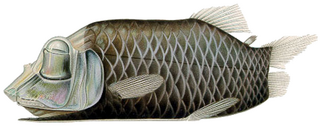
A tuna is a saltwater fish that belongs to the tribe Thunnini, a subgrouping of the Scombridae (mackerel) family. The Thunnini comprise 15 species across five genera, the sizes of which vary greatly, ranging from the bullet tuna up to the Atlantic bluefin tuna, which averages 2 m (6.6 ft) and is believed to live up to 50 years.

Mackerel is a common name applied to a number of different species of pelagic fish, mostly from the family Scombridae. They are found in both temperate and tropical seas, mostly living along the coast or offshore in the oceanic environment.

Herring are forage fish, mostly belonging to the family of Clupeidae.

Barreleyes, also known as spook fish, are small deep-sea argentiniform fish comprising the family Opisthoproctidae found in tropical-to-temperate waters of the Atlantic, Pacific, and Indian Oceans.

The billfish are a group of saltwater predatory fish characterised by prominent pointed bills (rostra), and by their large size; some are longer than 4 m (13 ft). Extant billfish include sailfish and marlin, which make up the family Istiophoridae; and swordfish, sole member of the family Xiphiidae. They are often apex predators which feed on a wide variety of smaller fish, crustaceans and cephalopods. These two families are sometimes classified as belonging to the order Istiophoriformes, a group which originated around 71 million years ago in the Late Cretaceous, with the two families diverging around 15 million years ago in the Late Miocene. However, they are also classified as being closely related to the mackerels and tuna within the suborder Scombroidei of the order Perciformes. However, the 5th edition of the Fishes of the World does recognise the Istiophoriformes as a valid order, albeit including the Sphyraenidae, the barracudas.

Monacoa grimaldii, also known as the mirrorbelly, barreleye, Grimaldi's barreleye, and flatiron fish, is a species of fish in the family Opisthoproctidae. Different sources express different views on its distribution. According to Poulsen and colleagues, it is known with certainty only from the Atlantic Ocean, with records from the Pacific Ocean representing other Monacoa species. However, FishBase and Catalog of Fishes include the Pacific, and in the case of the latter, the Indian Ocean in its range. It is typically mesopelagic, but it has been recorded from depths of 0 to 4,750 metres. It has a body length of 8 cm (3.1 in) SL.

Thunnus is a genus of ocean-dwelling, ray-finned bony fish from the mackerel family, Scombridae. More specifically, Thunnus is one of five genera which make up the tribe Thunnini – a tribe that is collectively known as the tunas. Also called the true tunas or real tunas, Thunnus consists of eight species of tuna, divided into two subgenera.

The brownsnout spookfish or brown-snout spookfish is a species of barreleye in the family Opisthoproctidae. It and the glasshead barreleye fish are the only vertebrates known to employ a mirror, in addition to a lens, to focus an image in its eyes. This species probably has a worldwide tropical and temperate distribution; in the Atlantic Ocean it is known from Bermuda, the Bahamas, the Greater Antilles, and the Gulf of Mexico, and in the Pacific Ocean it is known from the California Current region and the South China Sea. It is found in the mesopelagic and bathypelagic zones at a depth of 500–2,400 meters (1,600–7,900 ft), but usually occurs below 1,000 meters. In the Gulf of Mexico it is found shallower, at 310–460 meters (1,020–1,510 ft).

An anchovy is a small, common forage fish of the family Engraulidae. Most species are found in marine waters, but several will enter brackish water, and some in South America are restricted to fresh water.

Coryphaenoides leptolepis, the ghostly grenadier, is a species of rattail found in the northern Atlantic and Pacific Oceans at depths of 610 to 4,000 metres. This species grows to a length of 62 centimetres (24 in) TL.

Opisthoproctus soleatus is a species of fish in the family Opisthoproctidae. It was first described in 1888 by Léon Vaillant. The species lives in most tropical seas, but is more common in the eastern Atlantic, from western Ireland to Mauritania and from Sierra Leone to Angola, and also in the South China Sea. O. soleatus can grow to a standard length of 10.5 centimetres (4.1 in) and usually live from about 500 to 700 metres deep.

Dolichopteryx is a genus of barreleyes.

The yellowtail reef fish is a species of damselfish in the family Pomacentridae.

Monacoa is a genus of fish in the family Opisthoproctidae found in Atlantic and Pacific Oceans. They are also known as long-nosed mirrorbellies or simply mirrorbellies, in reference to the bioluminescent organ in their intestines. The largest species, Monacoa grimaldii, can grow to 8 cm (3.1 in) standard length.
Dolichopteryx minuscula is a species of fish found in the Indo-West Pacific including Mauritius and Japan.
Dolichopteryx rostrata is a species of fish found around the Hebrides Islands in the north-eastern Atlantic Ocean.
Dolichopteryx pseudolongipes is a species of fish found off California and Galapagos Islands in the eastern-central Pacific Ocean.
Dolichopteryx andriashevi is a species of fish endemic to in the Philippine Sea.
Dolichopteryx vityazi is a species of fish found in the Pacific Ocean.
Dolichopteryx trunovi, the tailspot barracudina, is a species of fish found in the oceans of the Southern hemisphere.











